Ever thought about turning a tiny tree into a big part of your life? Growing bonsai trees could be the perfect hobby for you. This guide on how to grow bonsai trees will show you how to care for these miniature marvels and make them a centerpiece in your home or garden.
I’ll cover everything from picking the right tree for your space to essential care tips like watering, pruning, and soil selection. You’ll learn how to keep your bonsai healthy and looking great, whether it’s an indoor or outdoor variety.
Ready to dive into the world of bonsai? Let’s get started on this rewarding journey of growing and shaping your bonsai trees.
7 Key Takeaways on How to Grow Bonsai Trees
- Bonsai is an artistic technique, not a specific tree species, used to shape miniature trees.
- Different bonsai tree varieties are suited for indoor or outdoor cultivation depending on climate and care needs.
- Proper bonsai soil must balance water retention, drainage, and aeration, with specific mixes varying by species.
- Watering bonsai requires careful attention to soil moisture, with adjustments for seasonal changes.
- Most bonsai trees need abundant light, with requirements varying by species; indoor trees may need supplemental lighting.
- Pruning and wiring are essential techniques for shaping and maintaining bonsai trees, each with specific methods.
- Repotting bonsai every 2-5 years is crucial for maintaining healthy roots and overall tree health.
Bonsai Tree Overview
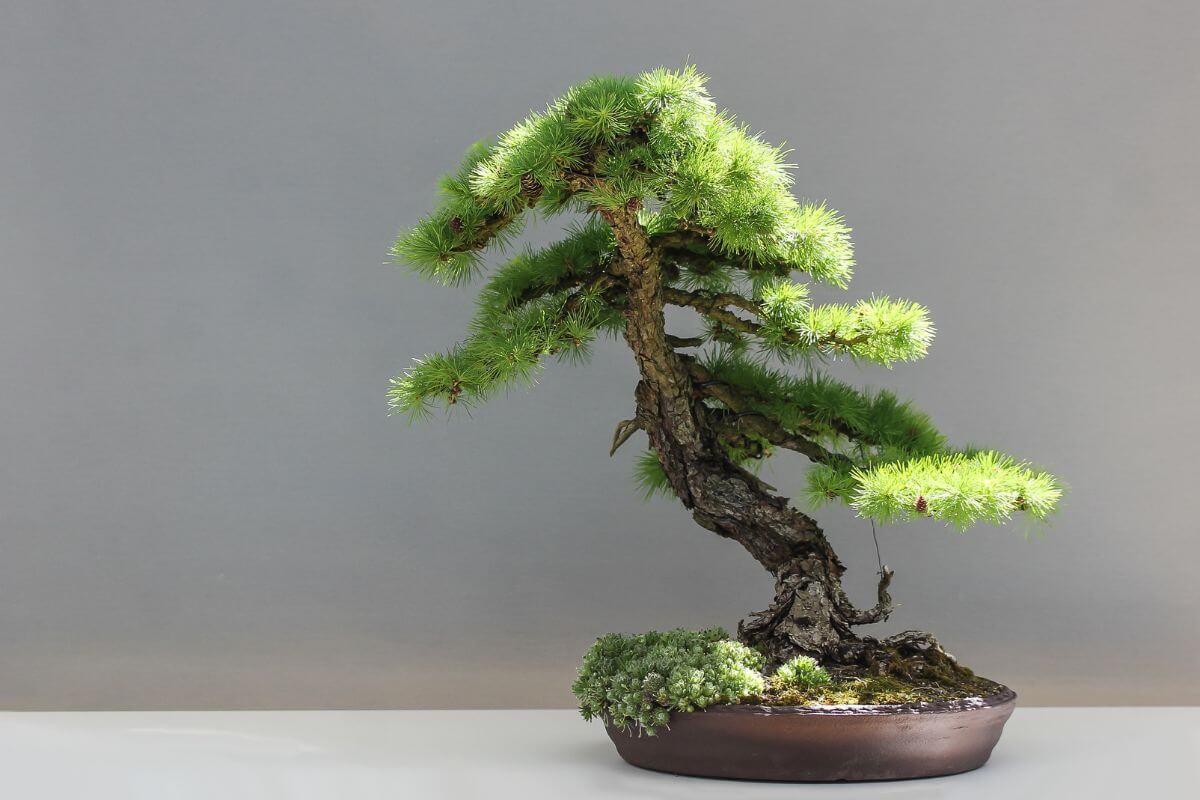
For those of you who perhaps think of a “bonsai” as a species of tree, it is not.
“Bonsai” refers to the methodology applied to shaping a tree artistically. These techniques and art forms can be used on a multitude of different species of trees. It comes from the Japanese words for “tray” and “planting”, highlighting the practice of growing trees in shallow pots.
Not all species will necessarily be adaptable to becoming bonsai trees. Some will be easier than others. Different types of tree species will also grow at different rates.
Unlike genetically dwarfed plants, bonsai plants are regular plants kept small through techniques such as:
- Pruning – Regular root pruning and foliage trimming are important to control growth and shape.
- Wiring – Using wire to guide branches into desired positions.
- Defoliation – Removing leaves to encourage active growth and maintain size.
These methods enable bonsai artists to create miniature trees that resemble full-sized trees, capturing their essence in a compact form.
Bonsai Tree Varieties
The kind of tree you select for your bonsai will depend on the climate where you reside and where you will position your bonsai tree. Do you plan on cultivating an indoor bonsai or planting an outdoor bonsai tree?
Not all species will do well indoors, because temperatures don’t change much, and it is less humid than outside.
Bonsai trees, like regular outdoor full-sized trees, do better when four seasons include a period of dormancy that occurs in the winter.
However, there are bonsai tree varieties that thrive indoors, such as:
- Ficus (Ficus microcarpa) – Also known as the Ginseng Ficus, this is one of the most common indoor bonsai trees. It is favored for its resilience and attractive root structure.
- Fukien Tea (Carmona retusa) – Recognized for its small, glossy leaves and the ability to produce tiny white flowers, the Fukien Tea bonsai is a favorite among indoor growers.
- Hawaiian Umbrella Tree (Schefflera arboricola) – This tree is valued for its distinctive leaf shape and ease of care, making it a great choice for beginners.
- Brazilian Rain Tree (Pithecellobium tortum) – Known for its unique, twisting branches and delicate foliage, the Brazilian Rain Tree can thrive indoors with proper care.
- Ponytail Palm (Beaucarnea recurvata) – While not a true palm, this succulent tree is popular for its bulbous base and long, arching leaves, and it adapts well to indoor conditions.
- Jade Plant (Crassula ovata) – Often grown as a bonsai, the Jade Plant is a succulent that requires minimal care and can thrive indoors with adequate light.
If you have a yard, outdoor garden, or space, you will have more choices. Some outdoor trees include:
- Japanese Maple (Acer palmatum) – Japanese Maple offers vibrant colors throughout the seasons, making it visually appealing year-round.
- Junipers (Juniperus spp.) – These coniferous trees are highly adaptable and come in various forms. They are hardy and can withstand harsh weather conditions.
- Pine (Pinus spp.) – Various species of pine, such as the Eastern White Pine and Japanese Black Pine, are popular for bonsai. They are resilient and can thrive in outdoor environments.
- Chinese Elm (Ulmus parvifolia) – This deciduous tree is favored for its ability to adapt to different climates and its attractive bark.
- Azalea (Rhododendron spp.) – Known for their beautiful blooms, azaleas are excellent outdoor bonsai options.
- Crabapple (Malus spp.) – This tree not only provides beautiful flowers in spring but also produces small fruits, adding interest throughout the year.
- Beech (Fagus sylvatica) – Beech trees are hardy and can develop stunning foliage, making them a great choice for outdoor bonsai.
Bonsai Technique and Care Guide
Here are some general concepts to help your bonsai tree thrive in your care. These trees can live for hundreds of years with proper care and maintenance.
Soil Requirements for Bonsai Trees
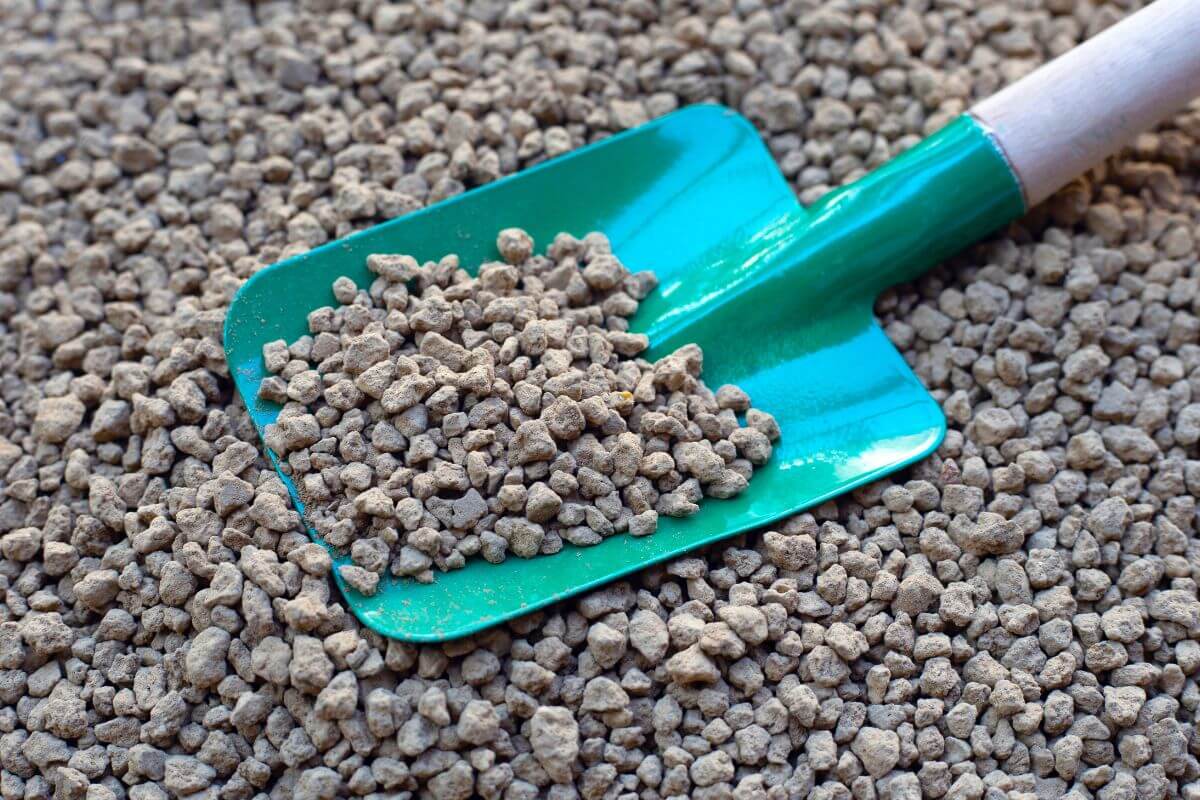
Bonsai soil must meet three critical criteria: good water retention, drainage, and aeration. It should retain sufficient moisture while allowing excess water to drain quickly to prevent root rot. Additionally, it needs to have enough air pockets to provide oxygen to the roots and support beneficial microorganisms.
Common soil components for Bonsai soil mix:
- Akadama – A hard-baked Japanese clay that eventually breaks down, requiring repotting.
- Pumice – A volcanic rock that aids in water retention and aeration.
- Lava Rock – Provides excellent drainage and aeration.
- Organic Potting Compost – Adds water retention but is not always necessary.
- Fine Gravel (Grit) – Enhances drainage and aeration.
Different bonsai tree species require different soil mixtures:
- Deciduous Trees – A typical mix includes 50% akadama, 25% pumice, and 25% lava rock.
- Conifers – Often use a mix of 33% akadama, 33% pumice, and 33% lava rock.
Adjustments may be needed based on local climate conditions. In wetter climates, add more lava rock or grit to improve drainage. In drier climates, increase akadama or organic compost to boost water retention.
Water Requirements for Bonsai Trees
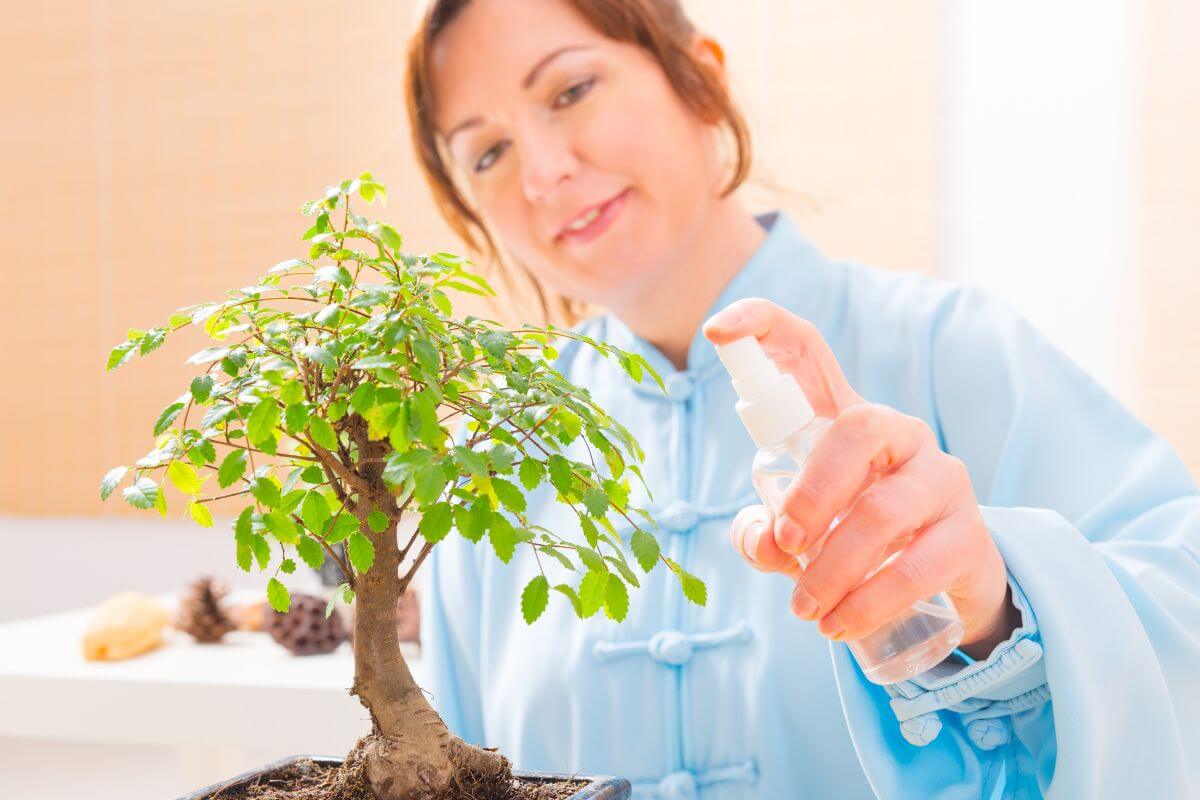
The frequency of watering bonsais depends on the tree species, soil mix, and environmental conditions. Generally, water bonsai trees when the topsoil feels slightly dry.
Water thoroughly until water drains out of the bottom of the pot. This ensures the entire root system is moistened. Avoid letting the soil dry out completely, as it can harm the tree.
How often should you water bonsai? Watering needs can vary with the seasons. During the growing season, bonsai trees may require more frequent watering. In dormant periods, less frequent watering may be sufficient.
Light Requirements for Bonsai Trees
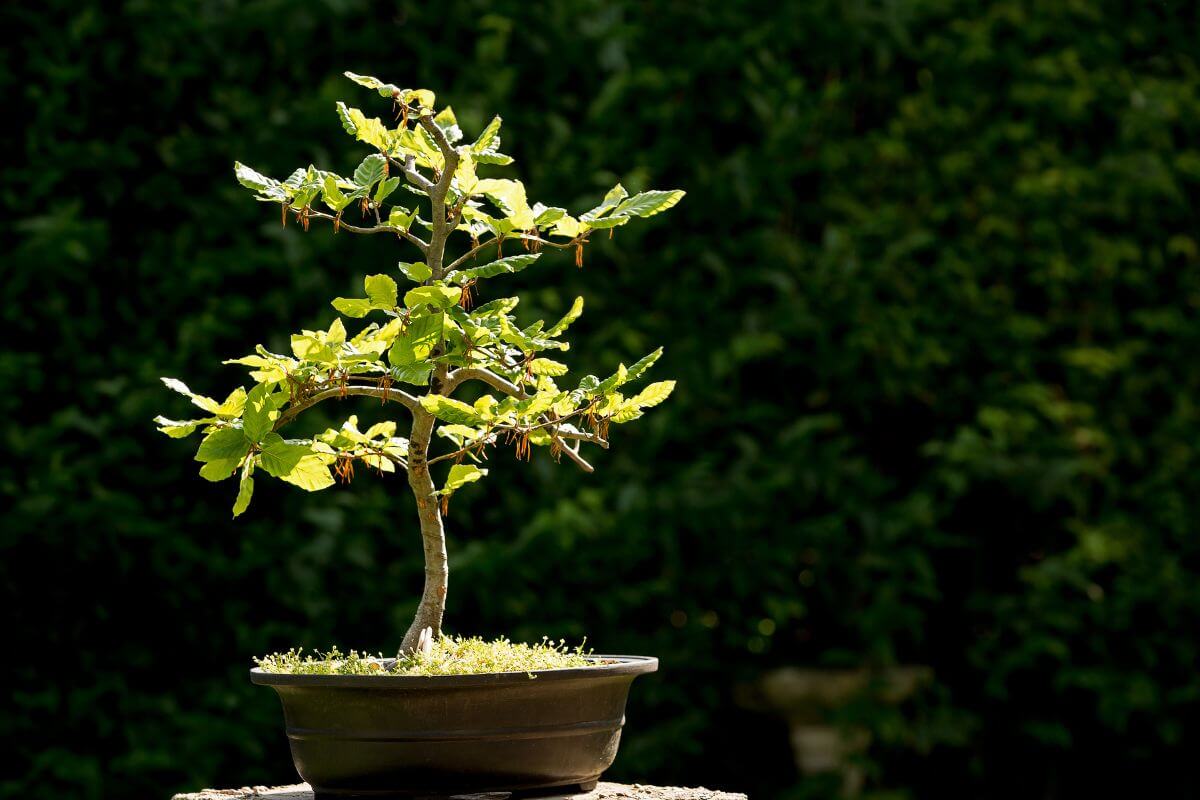
Most bonsai species need abundant light, with many requiring at least 5-6 hours of direct sunlight daily. Outdoor bonsai should be placed in locations that receive morning sun and afternoon shade to protect from intense midday heat.
For indoor bonsai, a south-facing window is ideal, but supplemental grow lights may be necessary, especially during cold winter months.
Light preferences by species:
- Full Sun – Junipers, pines, and flowering fruit trees thrive in full sun.
- Partial Sun or Indirect Sunlight – Maples, elms, and ficus prefer partial sunlight.
- Shade Tolerant – Azaleas and ferns can tolerate more shade.
Leggy growth, yellowing leaves, and leaf drops indicate insufficient light. Conversely, too much direct sunlight too quickly can cause sunburn.
When changing the light conditions, gradually acclimate your bonsai to prevent shock. Rotate indoor bonsai regularly to ensure even growth. Monitor your trees closely and adjust their positioning as needed to maintain optimal light exposure.
How to Prune Bonsai Trees
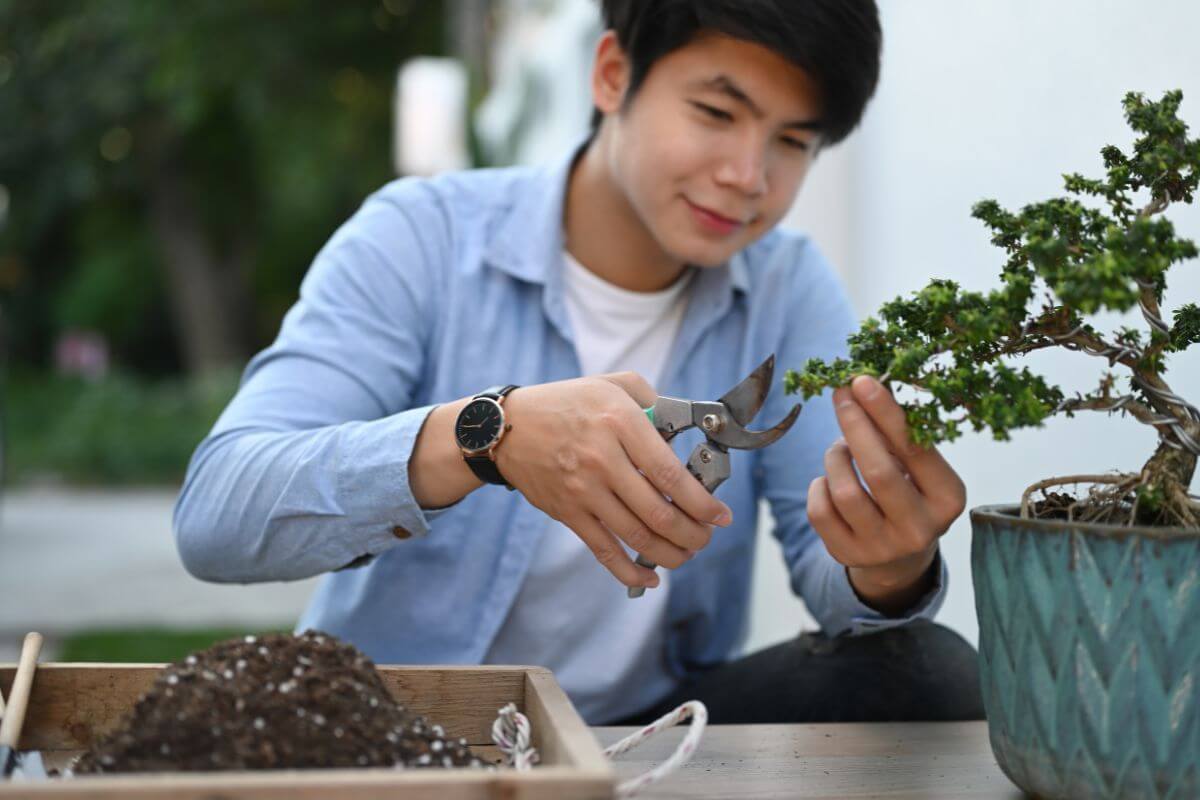
Pruning is essential for shaping and maintaining bonsai trees. There are two main types of pruning: maintenance pruning and structural pruning.
Bonsai Maintenance Pruning
This involves regular pruning to maintain and refine the bonsai’s shape, typically done throughout the growing season (April to September for outdoor bonsai). The goals are to control growth in the top and outer portions of the tree, encourage growth in the inner and lower parts, maintain the desired canopy shape, and develop dense foliage and fine ramification.
When doing maintenance pruning for Bonsais, follow these tips:
- Use twig shears or regular cutters to trim broken branches and shoots that have outgrown the intended shape.
- Prune about four times a year, removing around 10% of the foliage each time.
- For pine trees and some conifers, pinch new growth by hand instead of using scissors to avoid brown, dead foliage at the cut ends.
Bonsai Structural Pruning
This is more rigorous pruning to give the tree its basic shape or style. It involves removing large branches to define the tree’s structure, using concave cutters to minimize scarring, and applying cut paste to large wounds to protect against infections and promote healing.
When performing structural pruning, it’s generally safe to remove up to 1/3 of the tree’s foliage. However, it’s advisable to undertake only one major maintenance task per year to allow the tree to recover fully.
Fertilizer for Bonsai Trees
If your bonsai has not reached the size you desire, it should be placed on a feeding schedule. A fully grown, mature bonsai will require occasional fertilization.
Both mineral and organic fertilizers can be used. A dose of a balanced liquid fertilizer bi-weekly is ideal.
When it comes to bonsai fertilizer, you’ve got two main types to choose from: liquid and solid. Liquid fertilizer is like a quick snack for your tree. You need to use it often because it washes out of the soil quickly. On the other hand, solid fertilizer, whether in granules or spikes, works slowly over time. You apply it less frequently, and it releases nutrients into the soil gradually.
There’s also the choice between organic and synthetic fertilizers. Organic fertilizers come from natural stuff like manure, fish, or seaweed. They’re great for making the soil healthier. Synthetic fertilizers are made in labs and usually have more nutrients. But watch out for urea in them because it can hurt your bonsai.
If your bonsai is growing actively, feed it throughout the growing season. For mature trees, fertilize after the spring growth has toughened up and continue until the end of the season. Sick trees or those with pests don’t need as much fertilizer so be careful with them.
- Read more: Quality Bonsai Fertilizers
Bonsai Wiring Guide
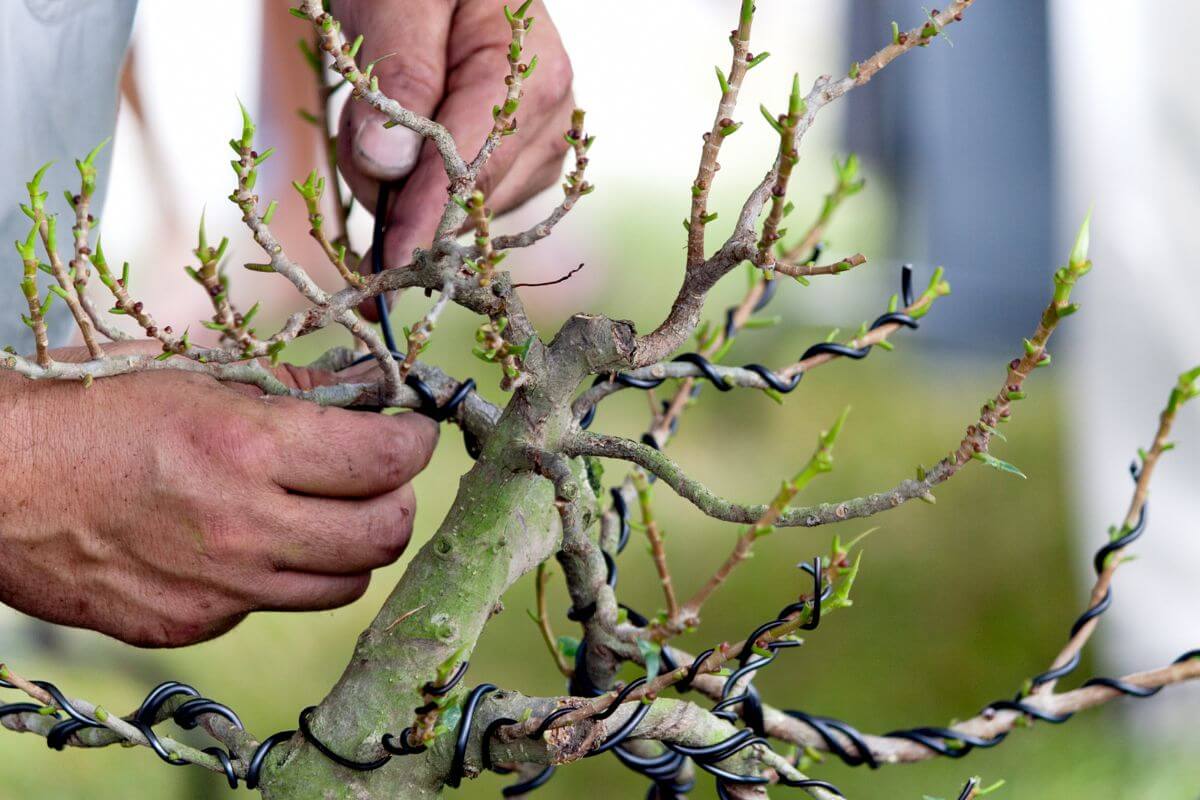
While most beginners shape their bonsai by pruning it, experienced bonsai artists also use wiring together with pruning. Bonsai wiring is the method used to move the bonsai’s branches in one direction or another to help with the shaping of the tree.
When wiring, a bonsai artist will wrap a branch of the tree with wire and then position the branch thanks to the wire in the desired direction of the shape. This helps the branch to grow in a specific direction.
Most tree species can be wired at any time of the year, but deciduous trees are easier to wire in late winter when they are leafless. During the growing season, it’s crucial to check the wires regularly to prevent them from cutting into the bark as branches thicken.
Types of bonsai wires:
- Anodized Aluminum – Recommended for beginners and deciduous species due to its malleability and ease of use.
- Annealed Copper – Preferred for conifers and pines because it is stronger and holds its shape better once applied.
How to wire a bonsai tree:
- Preparation – Before wiring, ensure the tree is healthy and has been watered recently. This makes the branches more flexible.
- Double Wiring – Whenever possible, wrap wire on two branches of similar thickness near each other using a single piece of wire. This provides better support.
- Single Wiring – For branches that cannot be double-wired, use single wiring. Always start wiring from the trunk to the primary branches, then move to the secondary branches.
Hold the outside of the branch with your fingers and bend from the inside with your thumbs. This technique helps reduce the risk of splitting. Once the branch is positioned, avoid moving it further to prevent damage.
Regularly check the wires during the growing season to ensure they are not cutting into the bark. Depending on the tree’s growth rate, wires may need to be removed within 1-4 months. When removing the wire, cut it at every turn rather than attempting to unwind it. This prevents damage to the tree.
How to Repot a Bonsai
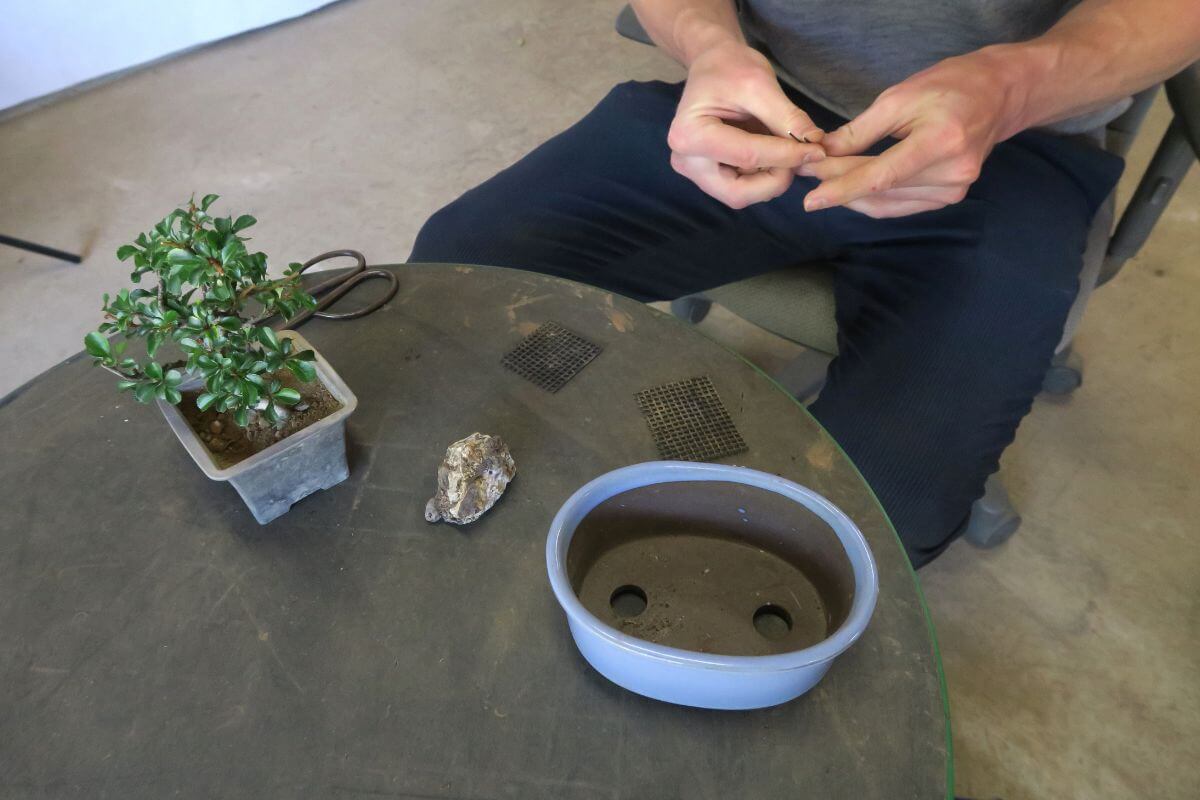
Repotting is an essential maintenance task for bonsai trees, typically done every 2-5 years depending on the tree’s growth rate and species. Here’s a brief guide, focusing on the root ball:
- Repot in early spring before new growth begins.
- Gather fresh bonsai soil, clean tools, and an appropriate pot.
- Carefully remove the tree from its current pot, preserving the root ball. Root rakes, chopsticks, and tweezers are helpful tools for this process.
- Trim 1/3 to 1/4 of the roots, focusing on thick ones, to maintain a healthy root system.
- Add a drainage layer to the new pot for optimal drainage and aeration.
- Position the tree and fill the pot with fresh soil, working it in around the roots and root ball.
- Thoroughly water the newly potted tree to help settle the soil and eliminate air pockets.
- Place the tree in a sheltered spot for a few weeks and avoid fertilizing for about a month to allow it to recover.
Younger trees generally require more frequent repotting than mature ones. Always use a proper bonsai soil mix to make sure you have drainage holes and aeration around the root ball.
Bonsai Educational Resources
If you are new to cultivating bonsai trees, it may be worth your while to search for a class or workshop in your area. Check to see if your local area has a Bonsai Society or association.
There are many great bonsai books too. See my list of the Best Bonsai Books.
Meeting and working with experienced bonsai artists will assist you if you have any doubts about the best care for your tree.
If your area is not home to a group of local bonsai enthusiasts, there are quite a few resources available online with some great videos to help you get started too.
Growing Bonsai Trees Final Thoughts
Ready to dive into the world of bonsai? You’re in for a treat! This green art form is not just fun. It’s a chance to work hand-in-hand with nature. Picture yourself shaping a tiny tree. It’s like being a sculptor, but your medium is alive and growing. The best part? You’ll end up with a stunning piece for your home or office.
I remember my first bonsai. It was a small juniper. I had no clue what I was doing, but I was hooked from day one. There’s something magical about nurturing a miniature tree. You’ll find yourself lost in the process, forgetting about the world around you.
How to Make Bonsai Trees FAQs
1. How Long Does It Take to Grow a Bonsai Tree?
The time required for a bonsai tree to grow depends on factors like climate, location, size, species, etc., ranging from two months to several years; growing a bonsai from seed can take up to 5 years to mature.
2. Can You Make Any Tree a Bonsai?
Yes! Many types of plants can be transformed into bonsais, as long as they are perennial trees that produce branches and can be kept small through cultivation.
3. Which Is the Best Bonsai Tree for Beginners?
While there are many varieties of bonsai trees, the dwarf Japanese Maple is recommended for beginners due to its ease of maintenance and beautiful foliage.
4. Why Do Bonsai Trees Grow So Slowly?
Bonsai trees grow slowly primarily because they are grown in containers, limiting growth, and often indoors under artificial conditions, which reduces their growth rate.
5. Why Are Bonsai Trees Expensive?
Bonsai trees can be expensive as they are considered works of art; the care, techniques, and often handmade pots and tools used in creating bonsai can be costly and require years to master.
6. How Do You Grow a Bonsai Tree from a Cutting?
To grow a bonsai tree from a cutting, carefully remove leaves from a selected branch, plant it in potting soil, and water regularly; with patience and care, new shoots will grow in a few weeks.
For more growing guides, check out these houseplant articles:






